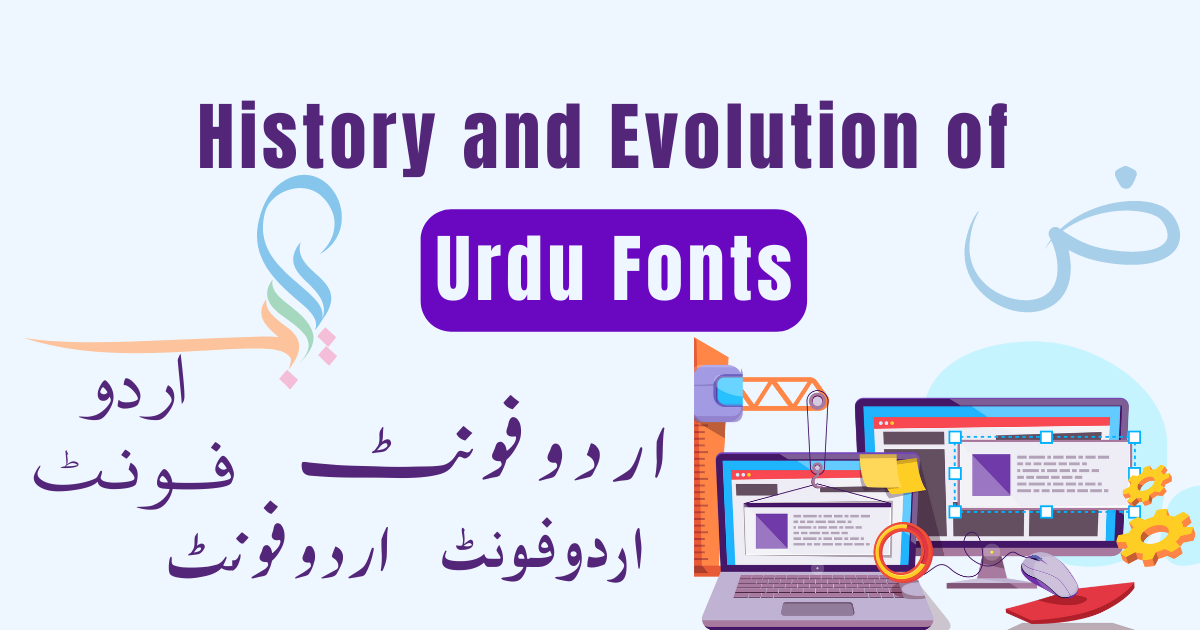In this article, you will learn about – The Mysterious History of Urdu Fonts.look at the history of computers reveals that in the beginning computers were used for defense, aerospace, and large businesses. But with the passage of time, its use for other purposes also became common.
Thus, individually, many organizations in the world started using computers for different purposes. Urdu computing was started by journalistic institutes in order to find solutions to the problems encountered in the writing of newspapers and magazines.
Mysterious History of Urdu Fonts
In this regard, the efforts of Ahmad Mirza Jameel and the Daily Jang Group succeeded in creating the first Urdu font. Muhammad Akbar Sajjad writes about these efforts, which began in the 1980s:
Urdu Fonts History: Ahmad Mirza Jameel
Efforts to develop Urdu processors on computers in Pakistan began in the 1980s. Monotype and Linotype companies had started these efforts earlier but the result was found in 1980. It is said that when Ahmad Mirza Jameel talked to Monotype Company about developing software for Urdu, he at first refused saying that it would be a failed experiment and the cost would be wasted but the insistence of Ahmad Mirza Jameel that if this happened, he would pay all the expenses himself, the monotype was in favor of the development of the Urdu word car.
Urdu Fonts History: Daily Jang
To further this endeavor, the daily Jang Karachi installed the first computer in its offices, which changed the course of decades and gradually replaced the scribes with computers. Thus the field of Urdu printing entered the machine age from humans. The cost of the computer that Jang installed in the 1980s was about Rs 5 million at the time. Its first exhibition was held in 1980 at the Urdu Science College, Karachi, organized by the Urdu Science Conference of the Scientific Society of Pakistan.
Ahmad Mira Jameel Nastaliq Font
The font developed by Ahmed Jameel Mirza was the first beautiful and best Nastaliq font in Urdu. He named it Noori Nasta’liq after his father Noor Ahmed. Later Urdu word processors (word car) also used drawings made by Ahmed Jameel Mirza. In 1982, the government of Pakistan awarded him the Medal of Pakistan for his services. About Mirza Jameel Ahmed Mushtaq Ahmad Qureshi writes in his article:
“May God bless Ahmad Mirza Jameel and his colleagues, who worked hard day and night to make Urdu Nastaliq a machine Urdu and put it in the forefront of the world. His father Noor Ahmad Dehlavi, a well-known Delhi calligrapher, is also involved in this work. Ahmed Jameel Mirza, who was well acquainted with the intricacies and all the codes of his father’s art, was well acquainted with the letters, the joints, the circles, and how to use them skillfully”.

He made this difficult task easier by involving some skilled people. In this regard, if the name of Mr. Mir Khalil-ur-Rehman is not mentioned, it will be abused. His encouragement and massive investment not only gave his newspaper the honor of being the first to use the computer on Urdu Nasta’liq but also made Ahmad Jamil Mirza world famous for his invention of Urdu Nastaliq. It is possible that the snow-covered Urdu, which was slowly melting like ice, was ‘extinct’. Suddenly it was filled with electricity and made Urdu Urdu. Because the computer runs on electricity and now modern Urdu is dependent on electricity.
Nouri Nastaliq Font
After that, the “New Time” group also transferred the handwriting to the computer. The system they developed was developed by Linotype Company. In terms of the beauty of writing, the Nouri Nastaliq font developed by MonoType was more beautiful than Linotype and this font became the standard for Urdu writing in the computer age. It worked. But after that, the use of computers for personal purposes also started and efforts were made to convert personal computers into Urdu so that ordinary users could also perform various tasks using Urdu computers.
Computer Era In Urdu Fonts Development
In this regard (1983 to 1985) efforts were not initiated by Tahir Mufti who did experiments on various personal computers during this period including HP and Apple II. With the help of his other friends, he not only tried to convert computer format into Urdu but also did practical experiments in preparation of Urdu word car, preparation of Nastaliq font as well as preparation of Urdu databases.
Saeed Karim Font
In June 1984, Saeed Karim developed a mini Urdu computer software that could be written in Urdu version along with English. Similarly, in June 1985, in the US state of Michigan, Pakistani-born student Tamiz Ansari developed computer software for the Urdu alphabet, which made the text clearer and more beautiful.
Urdu Computer Software Development
In September 1985, Fazlur Rehman Ali also developed a Developed word processor software (word processor). In 1978, Brigadier Hussain of Islamabad also started working on the development of Urdu computer software which his son tried to develop but he did not achieve much success. Coins In the same period, CC Simmons also analyzed the development of an Urdu computer system, which consisted of a script between Naskh and Nastaliq, with the aim of developing a cheap computer system that could benefit ordinary and small publishers.
How to Improve Fiverr Impressions ?
In Japan, progress was made in this regard and a system called “Aso Kayo” was developed on which it was possible to write in Urdu. A personal computer software called Khushnavis was also developed in the United States. , Tried to adapt Gujarati to personal computers and invented software called “Calligrapher”. In which the font named Khat Fateh was used.
Shahkar Urdu Publishing System
Similarly, the “Shahkar Urdu Publishing System” was introduced by Shahkar Computer Lahore in 1989. Then in 1989, the word “Nastaliq Nizami” was coined by Pakistan Data Management Service. These companies set the price of this software in the millions, which was not the case for the average consumer at that time. Yes, profitable businesses like publishing and press could definitely take advantage of them. During this period a software called “Sadaf” database was also developed.
The graphical interface gained popularity in the ’90s. Therefore, the need for a modern Urdu word processor running on Windows (word car) was felt which could meet the requirements of the time.
Concept Software Pvt Ltd Development To Urdu Fonts
Concept Software Pvt Ltd, an Indian software company, has started regular work in this regard. It was headed by Narendra Singh and Vijay Gupta. The company also had a partnership with Multilingual Solutions, a UK company. The company developed a word processor called “InPage” in 1994, using the monotype and the Noori Nastaliq developed by Ahmad Mirza Jameel.
In addition to Noori Nastaliq, forty more Urdu fonts were added to this software. For more than a decade, this software has been a great support to the Urdu-speaking class and journalism in the field of Urdu writing. The rights to the software were later bought by Axis Softmedia Pvt Ltd, a Pakistani company.
But even today millions of users are using this software illegally. This software also played a role in the field of Urdu Internet and paved the way for the first time to create image sites on the Internet.
But the biggest objection of some friends on this page is that because of this we are far behind Arabic and Persian in the field of Nastaliq open type. Speed up But despite all these objections, the role of this page in Urdu computing can never be forgotten.
First Urdu Library Computer
In 1991, Syed Emad-ud-Din Qadri and his comrades started working on the first Urdu library computer system “Kitab Navees” and made it possible to prepare an excellent library database in which books in the Urdu language could be registered.
Urdu Fonts on the Internet by UNDP
The Internet was first introduced in Pakistan from Islamabad in 1993 with the support of UNDP (United Nations Development Program). The United Nations Development Program is a subsidiary of the United Nations aimed at providing financial assistance to developing countries for development work. In collaboration with UNDP, a company called Imran Net launched an e-mail service. The service also provided access to various newsgroups. Later, attempts were made to spread the word to other cities.
In 1994-95, a company called Digicom launched the first regular ISP from Karachi. At the same time in 1996, PTCL also started internet service. In view of the growing trend of the Internet, plans are underway to expand its reach to smaller cities. In 2000, Internet access was provided to almost all major and minor cities across Pakistan. Initially, it was just a dial-up facility but over time the process has improved.
And in the last years of the first decade of the 21st century, broadband has been provided to everyone in Pakistan. At the same time, wireless internet and mobile internet systems have been made more standard and efficient. Today, at least 20 million people in Pakistan use the Internetand easily write in Urdu Fonts with hundred of Urdu Uonts styles.


